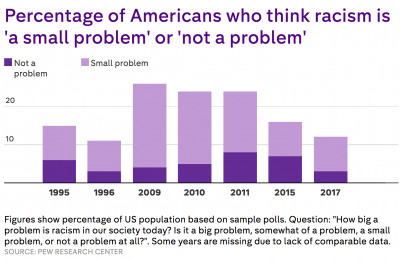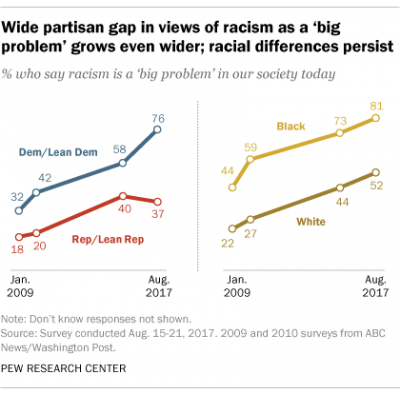I came across data from the Pew Research Center that has polled Americans over the last 20 years asking wether they think racism is a problem or not. The data is broken down further when presented in graphs in order to track the differences in answers over the past couples decades.
As you can see more people believe racism is a big problem today than they did 20 years ago. I thought this was interesting so I looked into some of the data further and saw graphs that compared these views with two other variables, wether the person was democrat or republican and wether they were white or black.
It is clear that both the whites and blacks that think racism is a big problem has increased over the past years. The republicans and Democrats also have seen this problem increasing. But, the democrats have exponentially increased the percentage of people who think racism is a big problem over the last few years while the republicans stayed at roughly the same percent.






I think the shift in opinions and increase of awareness is a natural shift due to a shift in societal norms. People are starting to realize that what was seen as a “normal” way to treat someone of a different skin tone was actually morally wrong. I think the exponential increase in one party compared to the other is due to the exposure one party is getting to the people that the racism has effected. If the republican party remains predominantly white, it is more likely that their old-fashioned views will not change.
This is a really fascinating post Ryan! I think it is really interesting, but very concerning, that Americans feel racism is more of a problem than it was 20 years ago. I would be curious to know who was sampled in the poll, when and where the poll was taken, and if a random and equally representational sample was taken or not, to see if the sampling pool was an accurate depiction of American racial attitudes.
This is a very important topic to analyze. I feel that the increase in perceived racism is extremely concerning and cannot believe that the increase from the past 20 years is that drastic. The graphs shown are very clear and simple to follow.
It’s important to point out that racism permeates society beyond just the race struggle between “blacks and whites,” but of other groups such as the large and growing Latinx community in America, Asian Americans who face different kinds of racism in media representation and stereotypes, and that’s only scratching the surface of the different kinds of race dynamics that happen in America. I also think racism, and the problem of it, is present in both the republican and democratic parties, as well as the other unrepresented parties in the provided graphs.